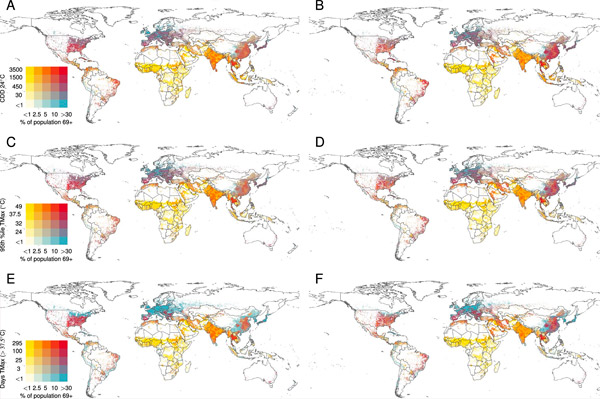Nye publikasjoner
Innen 2050 kan opptil 246 millioner eldre mennesker risikere å bli utsatt for høye temperaturer på grunn av den globale oppvarmingen
Last reviewed: 02.07.2025

Alt iLive-innhold blir gjennomgått med medisin eller faktisk kontrollert for å sikre så mye faktuell nøyaktighet som mulig.
Vi har strenge retningslinjer for innkjøp og kun kobling til anerkjente medieområder, akademiske forskningsinstitusjoner og, når det er mulig, medisinsk peer-evaluerte studier. Merk at tallene i parenteser ([1], [2], etc.) er klikkbare koblinger til disse studiene.
Hvis du føler at noe av innholdet vårt er unøyaktig, utdatert eller ellers tvilsomt, velg det og trykk Ctrl + Enter.

Et team av jordforskere og miljøvernere fra CMCC Foundation (Euro-Mediterranean Centre on Climate Change), sammen med to kolleger fra Boston University, har funnet bevis for at opptil 246 millioner mennesker over hele verden kan være i faresonen for varmestress innen 2050 på grunn av global oppvarming og en aldrende befolkning.
I artikkelen sin, som er publisert i tidsskriftet Nature Communications, beskriver gruppen hvordan de brukte klimamodeller til å estimere globale hotspots og sammenlignet dem med befolkningsprognoser for de samme områdene.
Planeten blir varmere på grunn av menneskeskapte klimagassutslipp som slippes ut i atmosfæren. Imidlertid vil ikke alle deler av planeten varmes opp like mye – noen steder, som deler av Afrika og Asia, forventes å bli varmere enn andre.
Dessverre øker også antallet personer over 60 år samtidig – antallet forventes å dobles innen 2050, og mange av dem bor i Asia og Afrika – land der klimaanlegg er sjeldent.
I denne nye studien bemerket teamet at selv om det er gjort mye forskning for å bedre forstå virkningen av ekstrem varme på eldre mennesker, er det gjort lite for å finne ut hvor mange av dem som kan være i faresonen i de kommende årene. For å finne ut av det, så de på både klima- og befolkningsmodeller frem til 2050.
Klimamodeller har vist at det gjennomsnittlige antallet ekstremt varme dager på verdensbasis vil øke fra omtrent 10 til 20 i løpet av de neste 30 årene. Forskerne fant også at disse varme dagene vil bli varmere avhengig av hvor de inntreffer.

Globalt skjæringspunkt mellom aldring og varmeeksponering i dagens klima (venstre kolonne) og rundt 2050, SSP2(45) (høyre kolonne).
A, B. Andel av befolkningen over 69 år som er utsatt for årlige kjølegraddager (CDD-er).
C, D. Årstemperaturer som tilsvarer 95. persentil av lokal ekstrem varmeeksponering (TMAX95).
E, F. Årlig antall dager med TMAX > 37,5 °C.
Kilde: Nature Communications (2024). DOI: 10.1038/s41467-024-47197-5
Og demografiske modeller har vist at omtrent 23 % av personer over 69 år vil bo i deler av verden som vil oppleve disse farlig høye temperaturene, opp fra bare 14 % i dag.
Totalt sett fant teamet at mellom 177 millioner og 246 millioner mennesker over 69 år kan bo på steder der farlig høye temperaturer regelmessig vil forekomme innen 2050, noe som setter mange av dem i fare for varmerelatert sykdom eller død.
